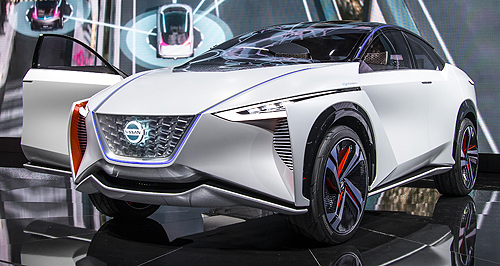Make / Model Search
Future models - Nissan - IMx - conceptTokyo show: Nissan goes driverless with IMx conceptCrossing over: The IMx crossover concept showcases Nissan’s autonomous tech as well as the auto giant’s new EV platform. All-electric Nissan IMx autonomous concept can drop you off and pick you upGallery Click to see larger images 25 Oct 2017 By TIM NICHOLSON in TOKYO NISSAN has revealed its take on autonomous mobility at the Tokyo motor show this week, with the all-electric IMx crossover concept that can drop you at the shops, park itself and then collect you when you’re finished and drop you home. The Japanese car-maker says the concept “provides a glimpse” into Nissan Intelligent Mobility, which is the company’s “approach to changing how cars are powered, driven and integrated with society”. At the heart of the concept is the future version of Nissan’s ProPILOT system first detailed in the forthcoming new-generation Leaf that is capable of full autonomous driving. When the system is activated, the steering wheel retracts and is stowed inside the dash, while all seats recline to ensure extra space in the cabin for occupants. If the user selects Manual drive mode, the steering wheel returns to its driving position and the seats go back to their original position, allowing the driver to take control of the car. Nissan Motor Company executive vice-president for global marketing and sales, zero-emission vehicles and the battery business, Daniele Schillaci, said the company wanted to shift how people interact with cars. “The IMx zero-emission crossover concept vehicle embodies the future of Nissan Intelligent Mobility,” he said. “Nissan is committed to changing the way people and cars communicate, as well as how cars interact with society in the near future and beyond.” Nissan says the IMx can contribute to “social infrastructure” by transporting the user/s to the airport and then drive itself to a car space where it can connect to the power grid and feed power back into the grid, acting as a “virtual power plant” as part of its vehicle-to-home and vehicle-to-building features. Upon the owner’s return, the IMx can come and collect them from the airport and return them home. Underpinning the IMx is a next-generation Renault-Nissan-Mitsubishi Alliance electric vehicle platform that was mooted by Carlos Ghosn last month when he revealed the automotive giant’s strategic plan out to 2022. It is unclear if the platform is the same as the one used to underpin Mitsubishi’s e-Evolution concept that was also revealed at the Tokyo show this week. Nissan says the platform is designed for “maximum efficiency”, meaning it has a flat floor and a spacious cabin as well as enhanced dynamics thanks to a low centre of gravity, making for sharp handling that the company says will “redefine the crossover segment”. The IMx uses two electric motors at the front and rear, ensuring all-wheel-drive traction, while delivering impressive outputs of 320kW and 700Nm from a high-capacity battery that has been tweaked for additional energy density. It can drive for 600km before requiring a recharge, exceeding the driving range of the upcoming Leaf by 200km. It is unclear if Nissan intends to simply use the IMx as a showcase for the autonomous and EV technology or if plans to develop a production version of the charged-up crossover. If it does get the green light for production, there will be few direct rivals from mainstream brands, however Jaguar will launch the i-Pace crossover EV next year and Mercedes-Benz is set to lob a production version of its EQ crossover concept in the coming years. Among other prestige brands, Audi is also preparing to introduce its E-tron Quattro and E-tron Sportback crossovers in the next couple of years. Design-wise, the IMx resembles the IDS concept shown at the 2015 Tokyo motor show which previewed the design of the second-generation Leaf that goes on sale in Australia late next year. It also features the familiar Nissan V-motion grille and character lines, while the ‘vermillion’ accent colour and pearl-white body colour is inspired by ‘uramasari’, which Nissan says describes relates to the “beauty and extravagance found on the inside of traditional Japanese kimonos”. The Japanese theme continues in the cabin, this time reflecting the concept of space found in traditional houses. A woodgrain panel that wraps around the cabin door trim gives a sense of being outside, according to the Nissan, while an OLED panoramic instrument panel has a display showing the external environment in the background. Drivers can control the instrument panel, thanks to artificial intelligence, simply by using eye movements and hand gestures, meaning there are fewer buttons and controls than in a traditional cabin.  Read more12th of September 2017  Nissan exec challenges Tesla, pushes Leaf ‘advantages’Leaf aims for mainstream, yet becomes a more advanced Nissan: execAll future modelsMotor industry news |
Click to shareNissan modelsResearch Nissan All future modelsMotor industry news |







































 Alfa Romeo
Alfa Romeo Abarth
Abarth Audi
Audi Aston Martin
Aston Martin BMW
BMW Bentley
Bentley Ferrari
Ferrari Chevrolet
Chevrolet Ford
Ford Fiat
Fiat GWM
GWM Foton
Foton Hyundai
Hyundai Honda
Honda Jaguar
Jaguar Isuzu
Isuzu Kia
Kia Jeep
Jeep Land Rover
Land Rover Lamborghini
Lamborghini Maserati
Maserati Lexus
Lexus McLaren
McLaren Mazda
Mazda Mercedes-Benz
Mercedes-Benz Mitsubishi
Mitsubishi Mini
Mini Peugeot
Peugeot Nissan
Nissan Ram
Ram Porsche
Porsche Rolls-Royce
Rolls-Royce Smart
Smart Skoda
Skoda Suzuki
Suzuki Subaru
Subaru Toyota
Toyota Tesla
Tesla Volvo
Volvo Zeekr
Zeekr







Facebook Twitter Instagram